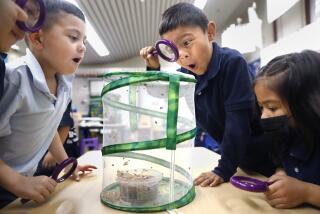A Telling Picture Gives Lie to a Thousand Education ‘Innovations’
No worse indictment of California public education could have been dreamed up than that depicted in the photo published in The Times on March 3. An adult in a funny hat is reading to a bunch of high school students. The picture is obviously intended as a promotion for the school district’s reading program. Let’s hope Gov. Gray Davis’s proposed educational reform are not as wrongheaded.
Devoting a week to beefing up reading skills sounds good. Even seeking a grant for more money to develop students’ reading abilities sounds fine, especially in light of California’s abysmal reading test scores. And you can’t quarrel with the reading aloud by a good reader of Dr. Seuss stories to children--or can you? All too frequently educational proposals, grants, even good intentions backfire through misapplication.
Look closely at that photo. This particular classroom exercise reinforces the idea of many adolescents that school is a joke. Like so many “innovative” activities, it also flaunts sound educational principles. As a superintendent of schools reads aloud, the students stare vacantly; they are not involved or participating in the lesson. Obviously a Dr. Seuss story is inappropriate for this age group. Perhaps, rightfully so, the students feel infantile in this situation.
The vignette demonstrates that the teaching goal, instilling the pleasure and wonder of reading, was not attained but exactly its opposite. The scene could have been photographed at the beach except for the student desks in the background. Several teenagers are barefoot; a girl with eyes shut is leaning against the shoulder of another student, who has his hand on her hip. Plates of partially eaten food sit on the floor. What is tacitly expressed is that education is not a serious business but rather farce.
Superintendents and school administrators determine curricula and methods (within state guidelines) and, most importantly, set the tone within a district or school. Whether the emphasis is placed on discipline, citizenship or creativity; competitiveness or cooperation between students, classes and neighboring schools; academic, artistic or athletic excellence, or novelty classes, they along with parents and school boards have much to do with the learning climate. Who is to review the actions of administrators and school boards in the governor’s plan?
This classroom scene is of students from an affluent district in which test scores are higher than in many other districts in Ventura County. A system of rewards and punishments meted out by the state based on a ranking of test-score improvements at first glance seems fair and one way to check on administrative inefficiency and boondoggles. But again, a closer look is indicated. Many districts with high test scores could score even higher with better, sounder educational programs. Many poorer districts with low test scores could already be performing admirably, given their lack of equipment, a transient enrollment and students with academically deficient backgrounds.
Gov. Davis is to be commended for his attempt at public school reform, but there is no easy fix for our schools. Voters say they want better education for children. However, school meetings regarding academic improvement for high school students draw only a trickle of parents. For a booster meeting of the varsity team, parents show up in droves.
Society itself must indicate that education is no beach party but a worthwhile endeavor.
After 25 years of insufficient funding for education and neglect from the public and politicians, California merits a mark of “unsatisfactory citizenship!”
More to Read
Sign up for Essential California
The most important California stories and recommendations in your inbox every morning.
You may occasionally receive promotional content from the Los Angeles Times.










